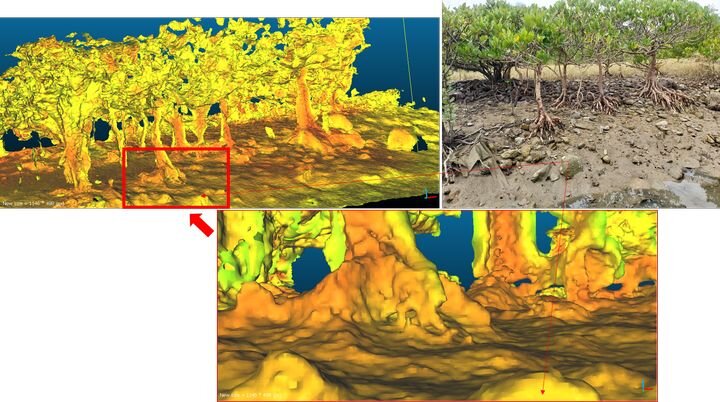![3D scanning a tree’s root system [Source: Rinaldi Gotama]](https://fabbaloo.com/wp-content/uploads/2020/05/image-asset_img_5eb08bfd8fa65.jpg)
This week’s question is from reader Rinaldi Gotama, who asks about 3D scanning.
Gotama, a Research Assistant at the School of Life Sciences in The Chinese University of Hong Kong asks:
“I am currently working on an ecology project in Hong Kong, in which we need to scan and print a portion of mangrove tree (1 x 1 x 1 m in dimension) for ex-situ experiments. My supervisor has previously done a similar project using the Kinect for Windows, however with the discontinuation of the product we need to look for an alternative.
The scanner we are looking for is something that we can bring to the field and scan our target trees in high resolution (we’re particularly interested in the shape and complexity of the roots). We have recently bought a GeoSLAM hand-held scanner, but it didn’t work as we expected. The point-cloud data we captured was very noisy and less accurate than the Kinect for Windows. An alternative I can think of is to use the new Azure Kinect, but I am not sure with its current availability in Hong Kong, or Orbecc.”
Thank for this very interesting question!
Gotama has sent along some images of the very peculiar tree and root system he is interested in scanning, and it does indeed look like an extremely tricky target for 3D scanning. There are plenty of hidden surfaces and complex geometry at play, and the subject is, of course, outdoors, where sunlight can play havoc with certain types of 3D scanners.
![3D scanning a tree’s root system [Source: Rinaldi Gotama]](https://fabbaloo.com/wp-content/uploads/2020/05/image-asset_img_5eb08bfdb8eca.jpg)
I am surprised you got as far as you did with the Kinect as it does not provide particularly fine resolution.
Also, the two options you mention, Orbecc and GeoSLAM seem to be oriented to applications other than object 3D scanning. It seems that the processing of scans can be optimized for certain types of objects. For example, I tried once to use a photogrammetry solution designed for UAV videos to process good quality object images, and obtained miserably bad results. You must use the right tool for the job.
You did not mention a budget for your project, so I’ll assume you have one, but prefer lower cost solutions.
Here are some possible solution approaches:
Use The Kinect
This one might be obvious, but if the Kinect solution was sufficient, why not keep using it? Even if unsupported, you can put off a move until it really doesn’t work — and at that time the prices will be lower and products will be better. You can even pick up Kinect devices at low cost on the used market to push this one out as long as the software still runs on your platform. I think I even have two or three Kinects lying around the lab here.
Photogrammetry
This would be my first “new” recommendation. Photogrammetry is a process in which a large number of still images taken from many angles are processed by software to reconstruct a 3D scene. For a 1 x 1 x 1 m scene, this should be quite doable.
The tools needed to do this are straightforward: a good camera and photogrammetry software.
For a camera, you likely already have a suitable camera on hand, but if you don’t there are some things to know. The camera should offer a reasonably large number of pixels, you want a lens and exposure setting that allows near and far simultaneously in focus. You’ll need to take a lot of images. By “a lot”, I mean hundreds. But that’s relatively easy to do.
For software there are multiple options, and there are several good ones, but the choice will depend on your budget, OS platform and graphics hardware (because some of the software uses graphics cards for intense processing.) Some very good options are:
-
3D Zephyr
-
MeshRoom
-
Autodesk ReCap
-
Agisoft MetaShape
However, you’ll have a bit of a learning curve to determine the best options, and each of them is different. Note that some are paid options, and some are quite pricey.
Handheld 3D Scanners
There are multiple handheld 3D scanners available, and two providers that immediately come to mind are peel 3D and Artec 3D.
Both of these provide a variety of handheld 3D scanner options, but note that they can be expensive. peel 3D’s latest offering is US$10,000, and the popular Artec Eva is priced at US$20,000.
Both of these devices use the structured light approach to 3D scanning. Basically, they throw a light pattern on the subject and their software observes how the pattern changes as the scanner is moved.
But there is a big problem with this option: sunlight. It is possible that sunlight might overpower the structured light pattern, making a mess of your 3D scan. You may have to do the scanning at night or with very overcast skies to succeed with a structured light 3D scanner.
There are laser-based handheld 3D scanners, but these can also be subject to sunlight and are even more expensive.
Occipital Structure Sensor
Another option might be the Occipital Structure Sensor. This is a specialized camera that straps onto an iPad and uses infrared light beams similar to the Kinect. Software installed on the iPad then uses the readings to reconstruct a 3D model. Occipital can bundle in some very good software called “Skanect Pro” to perform the work.
The Occipital option would be inexpensive, particularly if you already have an iPad handy. They sell brackets to fit several recent iPad models.
I hope this helps solve your dilemma. There are plenty of good approaches to try here, and I’d try photogrammetry first as it may offer the best result if you take sufficient images and get through the lengthy processing required.
Do any readers have further suggestions?

